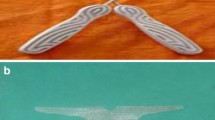Abstract
Despite multiple variations in cystocele repair techniques, success rates have been historically low. In this review we summarize strategies to optimize long-term results of vaginally approached cystocele repair for the high-grade defect. Our proposed strategies include addressing prolapse of the vaginal apex (the uterus or the vaginal cuff), using the obturator fascia as an anchor for lateral cystocele defect repair, augmenting the repair with loosely woven polypropylene mesh, and placing a midurethral sling.
Similar content being viewed by others
References and Recommended Reading
Rodriguez LV, Bukkapatnam R, Shah SM, Raz S: Transvaginal paravaginal repair of high-grade cystocele central and lateral defects with concomitant suburethral sling: report of early results, outcomes, and patient satisfaction with a new technique. Urology 2005, 66:57–65.
Sand PK, Koduri S, Lobel RW, et al.: Prospective randomized trial of polyglactin 910 mesh to prevent recurrence of cystoceles and rectoceles. Am J Obstet Gynecol 2001, 184:1357–1362.
Weber AM, Walters MD, Piedmonte MR, Ballard LA: Anterior colporrhaphy: a randomized trial of three surgical techniques. Am J Obstet Gynecol 2001, 185:1299–1304.
Gomelsky A, Rudy DC, Dmochowski RR: Porcine dermis interposition graft for repair of high grade anterior compartment defects with or without concomitant pelvic organ prolapse procedures. J Urol 2004, 171:1581–1584.
Winters JC, Fitzgerald MP, Barber MD: The use of synthetic mesh in female pelvic reconstructive surgery. BJU Int 2006, 98:70–76.
Rooney K, Kenton K, Mueller ER, et al.: Advanced anterior vaginal wall prolapse is highly correlated with apical prolapse. Am J Obstet Gynecol 2006, 195:1837–1840.
Kenton K, Guiahi M, Brubaker L: Isolated sacrocolpopexy improves posterior compartment defects. J Urol 2007, 177: Abstract 1287
Rutman M, Itano N, Deng D, et al.: Long-term durability of the distal urethral polypropylene sling procedure for stress urinary incontinence: minimum 5-year followup of surgical outcome and satisfaction determined by patient reported questionnaires. J Urol 2006, 175:610–613.
Amundsen CL, Flynn BJ, Webster GD: Anatomical correction of vaginal vault prolapse by uterosacral ligament fixation in women who also require a pubovaginal sling. J Urol 2003, 169:1770–1774.
Shull BL, Baden WF: A six-year experience with paravaginal defect repair for stress urinary incontinence. Am J Obstet Gynecol 1989, 160:1432–1439.
Barnes NM, Dmochowski RR, Park R, Nitti VW: Pubovaginal sling and pelvic prolapse repair in women with occult stress urinary incontinence: effect on postoperative emptying and voiding symptoms. Urology 2002, 59:856–860.
Gallentine ML, Cespedes RD: Occult stress urinary incontinence and the effect of vaginal vault prolapse on abdominal leak point pressures. Urology 2001, 57:40–44.
Brubaker L, Cundiff GW, Fine P, et al.: Abdominal sacrocolpopexy with Burch colposuspension to reduce urinary stress incontinence. N Engl J Med 2006, 354:1557–1566.
Goldberg RP, Koduri S, Lobel RW, et al.: Protective effect of suburethral slings on postoperative cystocele recurrence after reconstructive pelvic operation. Am J Obstet Gynecol 2001, 185:1307–1312.
Steers W: Abdominal sacrocolpopexy with Burch colposuspension to reduce urinary stress incontinence. Eur Urol 2007, 51:565–565.
Baessler K, Maher CF: Mesh augmentation during pelvic-floor reconstructive surgery: risks and benefits. Curr Opin Obstet Gynecol 2006, 18:560–565.
Meschia M, Pifarotti P, Bernasconi F, et al.: Porcine skin collagen implants to prevent anterior vaginal wall prolapse recurrence: a multicenter, randomized study. J Urol 2007, 177:192–195.
Clemons JL, Myers DL, Aguilar VC, Arya LA: Vaginal paravaginal repair with an AlloDerm graft. Am J Obstet Gynecol 2003, 189:1612–1618.
Amrute KV, Eisenberg ER, Rastinehad AR, et al.: Analysis of outcomes of single polypropylene mesh in total pelvic floor reconstruction. Neurourol Urodyn 2007, 26:53–58.
Gauruder-Burmester A, Koutouzidou P, Rohne J, Gronewold M, Tunn R: Follow-up after polypropylene mesh repair of anterior and posterior compartments in patients with recurrent prolapse. Int Urogynecol J Pelvic Floor Dysfunct 2007, In press.
Deng DY, Rutman M, Rodriguez L, Raz S: Correction of cystocele. BJU Int 2005, 96:691–709.
Author information
Authors and Affiliations
Corresponding author
Rights and permissions
About this article
Cite this article
Anger, J.T., Raz, S. & Rodríguez, L.V. Severe cystocele: Optimizing results. Curr Urol Rep 8, 394–398 (2007). https://doi.org/10.1007/s11934-007-0037-1
Published:
Issue Date:
DOI: https://doi.org/10.1007/s11934-007-0037-1




